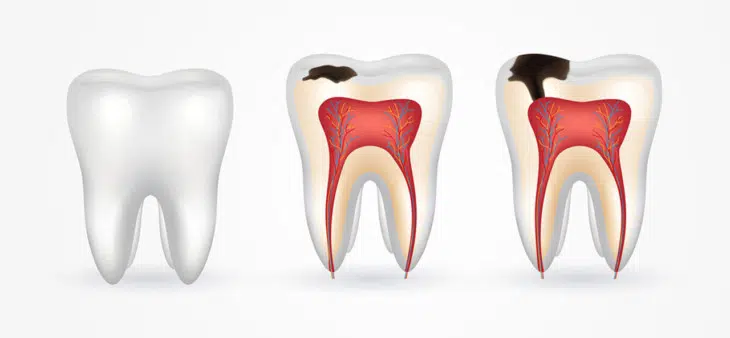
Root canal treatment is typically prescribed if the inner layer of your tooth, called the pulp, has become infected or damaged. In some cases, root canal therapy is the only way to save a tooth and prevent extraction.
A root canal involves making a small opening in the tooth’s crown to access the pulp chamber, removing the damaged tissue, and disinfecting the root canals. Once the pulp chamber is sterilized, the tooth is no longer alive. Your dentist then fills the tooth with a natural latex material and caps it with a crown, restoring its functionality and appearance.
Root canal therapy is often considered the final option before removing the tooth. There are several reasons why you might need a root canal to save your tooth.
1. Severe Decay
Decay occurs when plaque builds up on your teeth. This sticky film traps bacteria that produce acid as a metabolic byproduct. The acid erodes the porous outer enamel layer on your tooth, leading to cavities. These cavities can become infected, and the longer they are left untreated, the deeper the decay penetrates the tooth.
If decay reaches the root canal and infects the pulp, the only way to remove the damaged tissue is with a root canal treatment.
2. Multiple or Large Fillings
Large fillings or multiple procedures on the same tooth can cause damage to the pulp. This damage can cause pulpitis, an infection of the pulp tissue that can irreversibly damage the nerve cells inside the tooth, causing significant inflammation and pulp necrosis.
3. Tooth Discoloration
Trauma to the tooth can prevent blood flow to the pulp chamber, causing the tissue to deteriorate. This can cause your tooth to become tinged blackish-gray.
If you notice changes to the color of your tooth, visit your dentist for an exam. Tooth discoloration can have several causes, but if the interior of the tooth is damaged, you need a root canal to remove the infected tissue before it adversely impacts the gums and jawbone underneath.
4. Deep Chips, Cracks, or Broken Teeth
If you have sustained facial trauma or bitten something hard and it has caused a crack in your tooth that reaches below the gum line, you may need a root canal treatment. Deep cracks or a broken tooth can damage the nerves and blood vessels inside the tooth. They also allow bacteria to enter the pulp chamber, leading to an infection.
Deep chips or cracks cannot be repaired using dental restorations like fillings or dental crowns. A root canal removes the damaged blood vessels and nerves, then fills the tooth with gutta percha before capping it with a crown to restore its appearance and function.
5. Swollen Gums
Swollen gums could indicate that you have a dental abscess. An abscess is a pocket of pus that can form at the tooth’s root or on the gum tissue; however, abscesses can also develop in the pulp chamber, called a periapical abscess. They can be caused by a dental injury or a previous dental procedure.
A root canal is necessary to remove the bacterial infection, drain the abscess, and prevent the infection from spreading. If left untreated, a periapical abscess could cause life-threatening sepsis.
Save Your Smile With a Root Canal at A Dental Place
Good dental hygiene is the best way to avoid needing a root canal. Make sure to brush and floss twice a day. Also, don’t forget to make an appointment with A Dental Place for a routine cleaning and exam.
